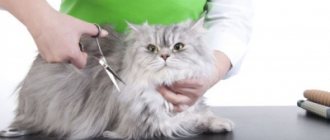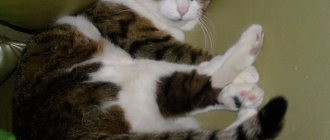Domestic cats are complex, highly organized creatures, with which problems can often arise due to a person’s lack of understanding of her reactions to various actions. To improve the quality of life not only for cats, but also for humans, you need to understand what conditions are preferable for a pet, their social organization, their habits - how they take food and water, use the toilet. Knowing the habits of an animal will help a person understand how to punish a cat and whether it needs to be done in a given situation. There are several common features that are characteristic of all cats.
A cat by nature is a hunter. Over the course of evolution, cats have developed the physical and behavioral characteristics they need to hunt. The natural rhythms of the animal are adapted to the time of day when its main prey - small animals and birds - are most vulnerable - at dawn and at sunset. At this time, cats are most active, and activity is also higher in spring and summer.
A person needs to understand the habits and habits of a cat
The cat is a territorial animal. The area considered by the cat to be its own is a space in which there are resources necessary for survival and which must be protected. Therefore, many cats do not get along well with other cats, not only in the same house, but sometimes even in neighboring ones. When its boundaries are violated, the animal experiences a strong sense of danger, which can lead to both aggression and, conversely, an attempt to hide. Cats mark their territory in various ways - by rubbing against objects, leaving scratches or markings with urine.
Cats have a developed sense of smell; they are exposed to smells and sounds that are inaccessible to humans. They use scents, along with their keen sense of smell, as a means of communicating with each other, defining territory boundaries, and to keep other cats at a distance. Cats create scent marks that make them feel more confident. When they are calm and do not feel threatened, glands on their faces are used for marking. If the cat is unsure of its safety, then it may begin to use stronger signs by spraying urine.
Cats are very attentive, they have skills that allow them to react to danger with lightning speed, avoid it, noticing the probable source of danger. Cats can be bothered by sounds and smells that are common to humans, mostly new and unexpected ones. An animal can very quickly go on the attack if they are disturbed or unexpectedly frightened by a sudden movement or sound.
Cats react very quickly to danger
Cats generally fit well into human life. However, it happens that an animal cannot adapt well to new conditions, which sometimes causes problems. When under stress for a long time, a cat's behavior may show changes such as refusal of the litter box, fearfulness, or aggression. These reactions are part of their natural behavior, but do not always fit into human expectations from pets.
Features of cat behavior
Furry pets have existed alongside humans for more than 9,500 years. The domestication process began in Ancient Egypt and was completed about 200 years ago.
Despite many studies, scientists have not fully figured out the psychology of the relationship between cats and humans.
Regardless of ulterior motives, coexistence with these animals is beneficial for city dwellers. Scientists have proven that cats have a beneficial effect on the physical and emotional state of their owners, and also reduce the risk of stroke, myocardial infarction and other pathologies of the cardiovascular system.
Behavioral reflexes
To ensure that living together with an animal does not cause discomfort to both participants in the process, it is important to learn to understand the language of communication between pets.
Cats are considered good psychologists, excellent at capturing the mood of others.
Reading cats' emotions is difficult. Unlike dogs, they are not so open and are not capable of violent expressions of feelings.
Before punishing an animal, you should study the relationship between habits and provoking motives.
Table 1. How to decipher a cat's behavior?
| Behavior | Explanation |
| Licking hair and face | Demonstrating maternal instinct, the female licks the kitten. An adult pet copies the actions of its mother and thus shows care for its owner. |
| Bites the skin | Kisses. |
| Kneads the body with its paws | In the juvenile period, the baby massaged the mother’s belly with his paws to obtain milk. Subsequently, this gesture became an expression of the highest degree of satisfaction. |
| Brings dead mice | Teaches the owner the principles of hunting. |
| Touches a person's head | Shows his affection. |
| Demonstratively turns away | If a person is static, it means he is not showing signs of aggression. As a result, the cat calms down and loses interest in him. |
| Rubbing against legs | Leaves a smell, recognizing a person as its property. |
| Buries a bowl of food | You either don’t like the food or hide it for future use. |
| Licks after touching | Gets rid of human odor. |
| Throws himself to his feet | He asks the owner to play. |
| Slows down when passing another cat | Tries to avoid conflict over territory ownership. |
| Buries excrement | Masks its scent in order not to be detected by the enemy. |
Cats can imitate children
Sign language
The main devices for communication in furry pets are the tail, ears and “vocal apparatus”. By some signals you can understand the mood of the animal:
- The tail sticks out like a pipe - it is set up for active games.
- The ears are pressed tightly to the head, the tail is twitching - it is in a playful mood and is preparing to attack.
- The claws are extended, the body is pressed to the floor - scared and grouped for attack.
- The back is rounded as much as possible, the mouth is open threateningly - the highest degree of manifestation of fear.
In addition to body language, cats meow in order to convey information to the owner or other animals.
Purring is one of the ways of communication
Table 2. Decoding of some sound signals
| Sound Characteristics | Explanation |
| Fast, clear | "Hello!" |
| Constricted, chest | The pet is offended or complains about a situation that does not suit him. |
| Interrogative | Characteristic for communication between females and kittens. |
| Nadryvny | Signals pain in the body. |
| Growling | Showing dissatisfaction. |
| Yelling | The animal is scared. |
| Loud, shrill | A sound typical of cats fighting. |
| Lulling | "I love you". |
To quickly reach their owner, cats imitate the intonations of a crying newborn
Not punishment, but education!
A four-legged bully should perceive the owner’s actions not as punishment, but as an educational measure. It is recommended to punish him harshly, but without disrespect. Neglect and humiliation will not achieve what you want from the animal; on the contrary, it will begin to behave even more unpredictably. Choosing the wrong approach to raising a pet is fraught with the loss of his trust and the appearance of mental disorders.
Beatings should be prohibited. If you do not calculate your strength, you can seriously injure your cat. No matter how disgusting the cat's act was, it does not deserve such severe punishment. It will be possible to achieve exemplary behavior from the tailed prankster only with the help of consistency, determination, reasonable rigidity, refusal of moral pressure and physical influence.
Source
When it is necessary
If you are still ripe for punishment, you need to clearly define when it will be carried out. The decision depends on the circumstances and whether you are doing what is right for your pet. It is forbidden to “raise” a cat if you do not fulfill the following conditions well:
- Providing sufficient food;
- Providing warmth and comfort;
- Caring for cleanliness and health, timely visits to the veterinarian;
- Confidence that the cat is safe;
- Showing love and providing toys so that the cat can play and sharpen its claws enough.
If at least one point is not fully finalized, the cat simply asks for help. But if you do everything correctly, then move on to choosing the so-called punishment. First of all, remember that a cat is not a person, and he needs special ways to prove that he is doing wrong.
Solving health problems
Let's say that before your cat always willingly used the tray and litter, and there have been no changes in her life recently.
What then? It is best to take your pet to a doctor. Cats very often communicate their pain to us in this way. Get tested, check your internal organs using an ultrasound. Sometimes urination on upholstered furniture is a consequence of urolithiasis: it hurts the cat to urinate, and he looks for a softer place, in the hope that this will ease his suffering. But only timely treatment can alleviate them, so do not waste time raising the cat, but run to the veterinary clinic.
Another possible reason for bowel movements everywhere is helminthic infestation. Do not neglect regular preventive administration of anthelmintic drugs!
Source
Use intonation
The only thing we could recommend to you in case you need to convey your displeasure to the cat at any cost is a quiet but stern voice. Cats don’t know words, but they perfectly recognize intonation, and if you call him by name, the cat will realize that you are unhappy with him. Whether this will become a serious argument for him is another question.
In order to stop the cat right at the moment when he is about to misbehave, you can also imitate the sounds with which his mother cat reproaches the kitten: clicking the tongue and (in serious situations) hissing. These sounds have been familiar to the cat since childhood, and unlike the above unwanted types of punishment, the cat understands their meaning, so they will not cause the animal either stress or retaliatory aggression, but will trigger instinctive reactions that it developed in childhood.
We show attention and care
If everything is fine with the toilet, remember what recent events could have affected the state of the cat's soul. Perhaps you moved from your dacha to an apartment, and your cat suddenly found herself surrounded by smells that she had already lost the habit of, but couldn’t find her recent marks? Or perhaps there is a new smell in the house, especially a cat one?
An even more serious stress for a cat can be a change in family composition, the addition of a child or a new pet. In this case, a period of adaptation and the formation of new relationships is inevitable - we discussed this issue in detail in the article “Why do cats bury their feces.”
The most important thing to remember is that a cat begins to mark its territory when it feels threatened. If a cat’s world is stable, she has enough food, water and attention, and she feels safe, she will not have such a desire. Try to pay more attention to the animal, communicate more with it, do everything to make the cat feel that new residents or a changed environment do not threaten its well-being.
How to stop a cat from shitting in the wrong place
Owners obviously do not bring cats into the house for the purpose of running around with floor rags and wiping up foul-smelling puddles left anywhere. It is imperative to stop a cat from crapping: the peace of mind in the house and the comfortable coexistence of the family with the furry pet depend on it.
Furry pets can go to the toilet in flower pots, under and on the bed, on the carpet and in new shoes. A little more, and the apartment will become a cat's litter box...
When a cat shits in the wrong place, and does it with enviable consistency, any owner can lose his nerve. But you shouldn’t immediately scold the guilty purr, but take a closer look at the animal’s behavior and understand the reasons for the wet crime.
Methods of action depending on situations
When cats start damaging property or wallpaper, these are much more serious problems than theft and impudence. There are two ways out of this situation. You can buy a special scratching post and silently eliminate all the consequences of your furry pet’s fun without punishment. If the cat likes scratching posts or special toys, then in the absence of the owners he will stop damaging the furniture. Another option is to try to scare the animal when it intends to damage the furniture. To do this, you can use the same spray bottle, create noise by throwing a book, keys or other object on the floor.
When a kitten behaved inappropriately as a child, in order to punish him, the mother cat would take him by the scruff of the neck and hiss at him. This is exactly what you can try to do with an already matured person. So, in the language of purrs, you can explain to her that she is wrong.
Most owners are accustomed to the only way to deal with a cat that has gone to the toilet in the wrong place - to poke the pet’s nose into the puddle. In principle, there is nothing criminal or unacceptable in this method. You can punish a cat in this way. But it is advisable that before punishing an animal, you need to try to find the cause of what happened. Maybe this was completely due to the fault of the household :
- they forgot to remove his litter tray in time, but managed to punish him;
- They didn’t notice how much they had offended the animal before. Some cats constantly take revenge on their owners for the bathing procedure;
- A common reason for defecating past the toilet is territorial marking. The cat senses danger when another pet appears in the house.
When a cat shows aggression, you can know about it immediately. This is evidenced by her quivering, loose or raised tail, ears pressed to her head, and an unkind look. It is better to punish a cat for aggression using one of the humane and intelligible methods :
- threatening gesture with a finger in front of the cat's face;
- moderate tapping of the animal’s forehead with a finger;
- a verbal remark, said in a quiet, but stern and impressive tone, is also a way to punish;
- a light slap with a newspaper, towel, broom, napkin.
It is advisable to practice different methods of dealing with aggression, identifying the one that is more suitable for a particular animal. When a cat is angry, it can sometimes be difficult to influence him. When he is preparing to attack, he can only be stopped and punished by physical force. If all humane methods do not work on the cat, then it is necessary to show it to specialists to identify mental disorders.
How to properly punish a cat?
1. An animal must be punished immediately after committing an “illegal action,” otherwise it simply will not associate the punishment with the action and will continue to do so in the future. It is necessary to catch the cat at the scene of the crime and punish it no later than a few minutes after the dirty trick, otherwise new impressions in its mind will overshadow this act and it will associate the punishment with completely different actions.
Thus, if you returned tired from work and found a puddle on the carpet, a broken vase in the morning, or a torn chair, then it is too late and absolutely useless to punish. The cat has long forgotten about what she did. But if you start shouting at her and grabbing her by the scruff of the neck when she was walking joyfully to greet you or was lying relaxed, then you can seriously injure her psyche and, in a couple of such unfortunate times, lead the animal to depression. The cat will start to be afraid of you
2. You cannot humanize a cat and demand that it understand things that its brain is not able to understand.
For example, cats simply cannot understand the value of expensive items in your home. From the point of view of animals, the space of our apartment is filled with useless rubbish, which often prevents them from moving around comfortably.
A mink coat or an expensive merino blanket is just a soft and warm item that is good to lie on. From a cat's point of view, upholstered furniture and wallpaper are simply created in order to sharpen their claws and calm down (and without this, cats simply). Get used to the scratching post on time!
It is impossible to rebuild a cat’s consciousness in a human way, but it is simply necessary, with the help of constant repetitions, to consolidate in it the knowledge of what objects it should not touch (upholstered furniture), equipment, and you must secure all small, fragile and breakable things yourself by putting them away turnkey . It is in the nature of cats to drop small things, read more.
3.You should never hit a cat with your hands!!!
All animal behaviorists (behaviorists) and animal psychologists agree that after beatings, cats begin to act out much more actively.
To hit any animal hard is, firstly, vile and inhumane, and secondly, you can injure it under the heat of the moment.
If the cat has committed a really serious offense, do not hit it with your hands; you can slap it on the back (BUT NOT ON THE MOUTH AND HEAD) with a folded towel. Veterinarians and animal psychologists do not even recommend hitting cats with a newspaper.
Under no circumstances should a cat be hit on the back near the tail. In this place she has something similar to our solar plexus, that is, a sensitive collection of nerve endings.
But you can swing at a cat if it is going to harm you. Often such an impact is enough for her to get scared and retreat (or fight
How to raise a kitten
Many owners adore and idolize the "kote", allowing them to steal food from the plate, scratch furniture and sleep on the owner's pillow. If you don’t raise a cat after six months, the simplest combing of fur results in bitten hands and terrible stress, not to mention nightly praises and tactless invasions of personal space.
Only through learning the correct behavior and upbringing does a kitten become a member of the family. You shouldn’t turn an animal into a petty tyrant with your own hands.
War is war, but lunch is on schedule
To raise a respectable cat, it is important to follow the diet and basic rules of nutrition:
- They feed 4-5 times a day (one-time treats are not taken into account).
- In order to properly raise and instill in a kitten the manners of refined food consumption, only one place for feeding is allocated.
- A bowl of water is required.
- They either provide ready-made professional food or immediately formulate a natural diet.
- Everything that is not eaten at once is removed.
The cat’s eyes are unhappy, and she asks so pitifully - it’s simply a sin not to give the cutlet from the owner’s plate. If he steals something from the table, we won’t become poor. This is how the owner loses sight of the kitten's upbringing. And after a month the animal turns into an arrogant, ill-mannered, plump sausage with legs. Another extreme: pour a bowl of dry food (forgetting about water).
To avoid provoking your kitten to steal from the table, do not leave food (for humans) in easily accessible places. Not every cat born on the street will steal food from its owner. This is not a hunting instinct, as some people think, but permissiveness. If you are caught at the “scene of a crime,” spray it in the face with water (preferably from a spray bottle), slap it with a magazine with the command “no!”
Advice. For cats, hissing means aggression: adult cats make similar sounds before attacking. In order to defend his piece of sausage (and not only), the owner needs to learn to imitate a cat's hissing and it will become easier to raise.
Another problem in the education of gastronomic values: the pet refuses to drink from a bowl, but laps up the water from the tap. This could be a game. But better:
- replace the plastic saucer with a ceramic or metal one due to the unpleasant odor;
- do not give untreated water (who likes the smell of bleach!);
- Wash the bowl and change the liquid regularly.
To prevent flowing water from becoming the only entertainment, give a couple of toys, they will instill in the cat awareness and proper prioritization.
When there are several kittens in a litter, and the breeder feeds everyone from the same bowl, there is no time to think about proper upbringing; you have to quickly snatch away the tastiest things. If the baby pulls food out of the bowl and pulls it into a corner, lay an oilcloth there and slowly move the bowl to a place that the pet has determined is safe.
Communication in the game is useful. The owner raises a kitten, a girl or a boy, and learns to understand the mood by facial expression and posture in an interactive way. The baby understands how to behave and what line is not allowed to cross when playing with a person.
Hyperactive animals lack movement. To raise an affectionate cat, use:
- balls;
- clockwork and regular mice;
- rubber toys.
When the kitten, having started playing, grabbed his hand:
- They command “no”.
- As punishment, they lightly spank the ears, flick their fingers on the nose, or blow on the muzzle.
- Have water on hand - spray from a spray bottle.
Leave the animal alone for 20-30 minutes. If the attack continues, for educational purposes, lock the cat in the room until it calms down.
What to do to avoid biting
In rare cases, aggression in a pet is a consequence of excess sex hormones and metabolic disorders. To raise a cat who has rage attacks:
play with it wearing protective gloves (like an oven mitt); review your diet, drink catnip decoction; show your pet to the veterinarian.
Predatory play behavior, when a baby rushes from ambush to its feet, is a hunter’s instinct. Often the kitten does not have enough toys and is bored. Educational games will help to properly educate and correct behavior:
- mazes with a mink “guess where the food is”;
- tracks with a “catch the prey” ball;
- fluffy squeaking mice.
When several kittens live in a small area, fights are inevitable. Competition for a tasty piece, the warmest place, free access to the tray forces him to show his teeth. To prevent conflicts, the owner is obliged to create comfortable conditions for everyone (at a minimum, their own tray and plate).
How to wean a cat in adulthood
Owners of adult pets also face an unpleasant surprise. If a cat trained to use a litter box begins to relieve itself outside of the litter box, there are several reasons for this. The following situations may be the reasons for such behavior in an adult animal:
- A dirty tray that has not been washed well or the dirty litter has not been removed.
- Changing the location of the tray.
- The litter box has become small and does not correspond to the size of the grown cat.
- Replacing the filler.
How to stop a cat from pooping in the wrong place in these cases? It is necessary to return the usual filler, rinse the tray more often with warm water, and when moving it, place the toilet as close as possible to the place where it stood previously. If the cat puts marks for other reasons, then the owner will have to start processing these places. A popular method is to spray it with Antigadin spray; on the contrary, treat the tray with a special composition for training cats or put an additional container with filler.
How to stop a cat from shitting on the bed
A pet can make a mess anywhere; the owner can only immediately begin to solve the problem. It is especially not recommended to hesitate in a situation where a kitten is pooping on the bed. Your pet will develop the habit that the bed is a comfortable place to relieve itself. This problem also applies to adult animals, and experienced owners give the following advice on how to stop a cat from shitting on the bed:
- close the doors to the bedroom tightly so that the animal cannot get inside;
- treat the headboard with lavender oil;
- the pet experiences a lack of communication or jealousy, so it is necessary to pamper the cat more often, play, and pet it;
- not allowed to sleep on the bed next to the owner;
- Castration helps to discourage adult animals from pooping on the bed, sofa and other surfaces.
In flowers
For outdoor felines, burying excrement in the ground is the norm. Some pets are also susceptible to this instinct, so a kitten may start shitting in flowers, or less often an old pet. The following measures will help solve the problem of how to stop an adult cat from shitting in the wrong place:
- remove flower pots from the balcony or inaccessible places where the cat cannot get into;
- purchase mineral filler;
- cut the lemon peel or chop the garlic, placing them directly in the pot;
- Line the window sill with foil or double-sided tape.
On the beds
For furry predators, this is their own “hunting” territory that should be protected. In this way, the animal leaves peculiar marks for other brothers, declaring its rights. How to stop a cat from marking territory in open space? First you will have to find the reason, and the most common ones are an anxious state or the threat of invasion of other animals into its territory. The following recommendations will help correct the situation:
- Sprinkle the edges of flower beds and small beds with ground red pepper.
- Leave food because cats are clean creatures and will not go to the toilet near food.
- Lay out a plastic net for plants.
- Plant catnip and valerian away from the beds.
- Place rosehip, hawthorn or spruce branches along the beds.
At the entrance
A terrible smell in a confined space often occurs because a pet is allowed outside. How to stop a cat from shitting in a public place? Among the available remedies is to wash with acetic acid or bleach, then spread out the lemon slices. Effective products from the pet store - "Nature's Miracle", "Urine-Off" or others, which should be applied directly to the treated area.
Preventive measures
Bad actions can be prevented. The scratching post will protect the furniture; timely changing and cleaning of the tray will prevent the need to go to the wrong places. The owner can use safe repellers to prevent the cat from touching the flowers or jumping on the table or other surface. These include:
- citrus peels;
- foil or double-sided tape;
- rags (napkins) moistened with a strong-smelling liquid (cologne, perfume, solution of essential oils): special sprays.
A comfortable environment with a clear separation of permitted and prohibited areas will reduce the risk of bad behavior, especially if the cat has been in it since childhood. Socialized adults also quickly get used to the new rules. But no one is immune from excesses. Before punishing a cat, you need to understand what triggered the behavior.
Finding out the reasons
It is important to take your pet to the veterinarian regularly. Poor behavior is a potential sign of health problems. Cats of both sexes can mark territory due to urolithiasis and infections. Night screams and aggression are possible signs of pain.
Before choosing how to punish a cat, it is worth analyzing the changes in its life. Animals react sharply to the appearance of new residents, be it a pet, a child or an adult. Feeling deprived of attention, they begin to cause mischief. Bad behavior can be a reaction to:
- moving;
- sudden change of food;
- veterinary procedures, including haircuts, nail trimming;
- inappropriate treatment.
A cat, accustomed to sleeping with its owner, moves out when she has a roommate. A pet that has eaten chicken fillet is transferred to dry food or a meat and vegetable mixture. The result is the same – resentment and a desire for revenge. To achieve a truce, you will have to pay more attention to the cat and find incentives for good behavior (treats, toys). The approach also works when there is disobedience for no apparent reason.
Weaning off bad habits
Cats can be trained and remember the connection between action and result. Regular rewards for good behavior will reinforce it. Mild “punitive measures” can be used. There are several ways to punish a cat for bad behavior:
- sprinkler with water - spraying, an effective way to repel the animal; helps to switch over an aggressive pet;
- shout (single) – it is necessary to develop a reaction in the cat to the “safe word”;
- sharp sound - you can use beans, small stones in a tin can.
Along with shouting, you can threaten the cat with your finger. Animals do not like movements near their eyes. It is important to take action immediately after the crime. Otherwise, the cat will not connect the events, deciding that it suffered undeservedly. Instead of an educational moment, punishment will undermine the pet’s trust in the owner.
Controversial parenting methods
“Time out” and scruff lifting (sometimes recommended to be accompanied by hissing) cause conflicting reviews. Sending a cat to a “cage”—a bathroom or other room—for 15 to 20 minutes is considered a nonviolent disciplinary measure. But some believe that the cat will not understand the reason for the imprisonment.
Foreign sources are skeptical about the capture of the skin under the back of the head. The method is recommended to be used to immobilize the cat. In nature, animals are held by the scruff of the neck:
- in childhood;
- when attacked by a predator;
- during mating.
Kittens tolerate transportation calmly, since the structure of the mother’s teeth ensures painless pressure. In other cases, grabbing the scruff of the neck is stressful for the animal and has no educational effect. The pet will not like the punishment and will not understand the reason. Hissing can cause aggression.
Prohibited tricks
You cannot hit a cat or shout at it for a long time, even if there is great damage. The animal loses faith in its owner. Stress will increase negative behavior. Childhood trauma will make the animal nervous, reacting sharply to invasion of personal space. An attempt to pet such a cat will end in a bite or blow with a paw. It is important not to respond with aggression, but to try to correct your pet’s behavior peacefully.
Physical punishment is an ineffective method of training a mouser. The cat will take up arms against the owner or calm down, continuing to do nasty things on the sly. It is better to develop the habit of correct behavior in your pet, using rewards and non-violent punishment.
Using smells
In cases where the reasons for unwanted behavior are purely psychological, it is necessary to remember an important feature of cats: for them, the world is a map of smells. They apply them to everything that surrounds them, much like we write the names of streets and shops on a geographical map. If a cat went to the toilet in a certain place, it will return there and go again because it will be attracted to that place by the smell.
Therefore, it is best to wash the places where the cat has formed an illegal toilet with special products that fight off the cat’s odor very effectively. Read more about this in the article “Professional products: there will be no cat smell!”
Just do not use chlorine-containing products! Their effect will be the opposite. You can also use essential oils and scents that cats prefer to avoid; read about them in the article “The smell of what grass cats don’t like.”
In addition, there is another old folk way to calm a cat. Take any cloth, wipe your pet's fur with it, especially behind the ears, and then transfer this smell to the furniture and objects in your apartment. The cat will not have the desire to mark where the scent of its pheromones is already present, and in general it will feel safer.
Adult cats: why do they shit?
If we are talking about an adult cat, there is no point in rushing to punish. Particular attention should be paid to an animal that has suddenly changed its habits. The fact is that a pile in a visible place from a cat’s point of view is the best way to tell its owners: something is wrong with me! I feel bad!
Very often, the cause of this behavior is stress from a change in environment or fear. Negative experiences trigger a number of natural mechanisms in a cat that should ensure its safety, and one of them is to immediately mark its territory again, updating its scent everywhere.
Marks made throughout the apartment really calm the cat down, she begins to feel much more confident and relaxed, her life gets better... And then you come home from work. Screaming, chasing, grabbing by the scruff of the neck, beating with a slipper begins. What does the cat get? Stress and fear. What does a cat do when stressed? That's right: it shits. The circle is closed.
Methods of punishment for mischief
There are different ways to punish a cat for mischief. For example, when a cat tries to climb onto the table or steal food from it, you can prohibit the animal from doing this in a stern voice with a moderately elevated tone. If during the prank your eyes meet with the cat, he can easily read dissatisfaction on your face. To enhance the effect, you need to threaten him with your finger without sudden movements and loudly say “no!”
The fear technique also works on animals. To punish, you should not wave your hand at him; it is better to choose available means. This could be a towel, a spray bottle with a stream sent at the cat, a banal clap of your hands, or the creation of other noise. A cat will really not like it if you click it on the nose after doing something nasty and punish it with this.
The cat is constantly messing up
No matter how insulting and annoying it may be for you to find a puddle in your favorite shoes or puffs on a new chair, if your pet has been snoring heavily for a long time after committing bad actions, then there is no point in punishing him.
In addition, it can be dangerous, because cats are considered vindictive animals. Just as it seems to the cat that she received a punishment that she did not deserve, she will consider that the owner has become aggressive and angry towards her at any time. In such a situation, between the animal and the owner, the relationship will deteriorate, not to mention the fact that the cat may also begin to take revenge.
How to properly hold a cat in your arms
When holding your cat close to your chest, be guided by its habits and reactions. Every pet and owner is unique, and so will your relationship. However, there are a number of universal recommendations that will help you and your cat understand each other and enjoy communication.
- Hold your pet lightly against your chest, with its head and neck raised up - this is how the animal is most comfortable.
- The cat should sit on one of your hands, and it is best to support it under the chest with the other hand. If she doesn’t like it that way, she will take a comfortable position herself - the main thing is not to interfere with her initiative.
- Never lift your pet by the scruff of the neck! A mother cat carries her kittens this way, but this is only possible due to the small weight of the kitten. An adult animal weighs much more, so it will be painful and uncomfortable.
It is better not to handle newborn kittens at all - there is a risk of skeletal deformation. In addition, some cats are capable of abandoning their cubs due to the foreign smell.
Kittens should not be picked up too early
When not to pick up a cat:
with an unstable emotional state;
- while playing or hunting;
- during naps and sleep;
- during a fight.
In all these cases, the animal can react unpredictably aggressively. You should also not hold the cat with its paws up - in this position it feels trapped and in danger, and is able to wriggle out, scratching your face. Wash the affected area with soap and water, then treat with a topical antibiotic. For bites or deep scratches, consult a doctor.
How to let go of a cat? Do not throw it on the floor - an unsuccessful landing may cause injury. Gently place him on his paws as soon as he begins to show signs of displeasure.
Check the tray and change the filler
First, inspect your pet's litter box. Isn't it too small for her? Have you recently changed the filler? It may be worth changing it to another one, for example, a silica gel to a bentonite one, or even starting to use a flower pot, especially if the cat has already chosen it for the toilet.
Is the litter box always clean and dry? Perhaps she doesn't like the new air freshener or detergent you're using? Many smells that seem pleasant to us have a repellent effect on cats. You should not place the tray where you feed your cat; she will not defecate where she eats.
Methods of punishment
Moreover, if you are illiterate, situations may arise when you need to punish your pet. (it’s even better to change the word and say “not to punish”, but to instruct, that is, to instill good manners.
To instill such manners, it is appropriate to highlight two main methods: psycho-emotional and physical. They are often combined and act in tandem. One way or another, you need to understand the main thing: there is no need to make the punishment cruel, by all means (probably, this fact should not be explained to the one who decided to place the animal at home and take care of it, but still.
Cruelty will not only achieve nothing for you, but can also ruin the animal. In addition, your animal most likely understands the prevailing prohibitions and actions that should not be performed, and violates such prohibitions more than ever for psychological reasons, perhaps it requires attention or something similar, but we will not go into the details of animal psychology.
Ideally, your sister performs the educational action in such a way as to simply and calmly make it clear: this action cannot be performed.
The most common methods are the following:
- Waving your finger in front of your nose is more than effective; animals don’t like it when you move your finger like this edifyingly.
- To turn up your voice - just don’t shout (screaming has no effect), but (be a menacing and impressive voice, although here, too, don’t overdo it with psychological pressure.
- The wiper is a universal tool that can make whipping sounds from a sharp touch to the floor, it can be used to lightly spank the cat itself, the main thing is that it is not enough to twist it and not to swing it too much.
- A spray bottle and splashing water - they trigger reflex equipment, if you spray a spray bottle in the cat’s face once, he will remember this suggestion for a long period.
- Sharaban on the nose or on the forehead - both options require softness, you just need to lightly indicate the touch, but, of course, do not confuse such nivation with stroking.
These methods can be combined (for example, a menacing squeal and waving a towel) or act separately.
One way or another, you need to carry out the intervention immediately after the offense and only when you see how a cat has misbehaved in front of you, before your eyes, and not after some period. She’s an animal, she may simply not understand what kind of offense you are doing to him like this. Therefore, act with a single sigh after or simply stop negative actions if possible, for example, use your voice - many cats react to the word “no”.
Summary
In conclusion, you should say a few words about your attitude towards punishing pets. The facts of the action (punishment) should not become an end in itself.
If you lash out at your pet, and especially if you get bliss from physical or mental pressure on your cat, in all likelihood, the problem is not in your pet’s misdeeds, but in your psychological condition. Here, the decision to consult a psychologist becomes quite relevant Perhaps, see a zoopsychologist. Therefore, before trying to control and educate someone else, try to carefully control yourself, because you are responsible for those you have tamed.
Beating and humiliating a cat is useless and dangerous
Beating and humiliating a cat for educational purposes is the worst thing the owner of a guilty animal can think of. Humiliation and physical violence will not achieve obedience from your pet. He will not be able to grasp the cause-and-effect relationship between his behavior and moral and physical pressure; he will not be able to somehow connect these events.
Beating and humiliating a kitten or an adult cat is also prohibited for another reason. Felines have an extremely vulnerable psyche. Anything can throw them out of emotional balance. Many cats have a hard time traveling in a car, a change of scenery, the appearance of a child or a new four-legged inhabitant in the house, even moving to another room can have a negative impact on their psyche.
Screaming and physical impact on them can lead to severe mental disorders that will require long-term and expensive treatment. However, there is no guarantee that it will be successful.
Tailed bully is not recommended:
- Poking your nose into urine and feces. Poking in its own excrement will result in severe stress for the animal. It will begin to fear its owner, and its behavior will become even more unpredictable, if not inadequate.
- Beat. In the mind of the pet, physical punishment will be fixed not in connection with the action committed, but with the offender or the object with which he was punished, for example, with a slipper. As a result, he will begin to avoid shoes and the person who offended him, but will not stop doing what he was beaten for.
- You can’t stop doing something using the “no” command. These animals do not understand the meaning of this word, and perceive prohibitions as a violation of their personal boundaries.
Beatings and humiliation will not solve the problem. This will only push the pet away, but will not improve the situation. The only thing that can be done without harming the cat’s psyche is to lightly slap it on the back with your palm at the moment the “crime” is committed.
What lies behind bad behavior
Breakdowns in behavioral patterns always have a good reason. Since pets are unable to communicate verbally, they demonstrate their mood through changing habits and behavioral strategies.
Table 3. What is hidden behind bad behavior
Behavioral disorders Possible explanations Urinating on the carpet If the animal is physically healthy, this may be the way to express dissatisfaction with changing the litter. The arrival of a new person, rearranging the cat's furniture or changing the daily routine can also negatively affect the pet. Climbing onto the kitchen table In most cases, this offense does not carry a negative connotation. If an animal once, without the knowledge of its owners, feasted on a tasty dish lying on the table, the next time it will certainly repeat this action.
Puts its claws into the chair Lack of attention on the part of the owner or a sharp change in his attitude towards the pet. For example, if the owner played with the animal every day in the evening, and then suddenly stopped, the cat will perceive this as betrayal
Manifestation of obvious aggression Such actions can cause inconsistency in the behavior of the owner. If, depending on the mood, you either reward or punish an animal for the same actions, there is a high probability of provoking a behavioral failure. In most cases, the pet becomes aggressive and begins to take revenge on the owner.
Before taking educational measures, it is necessary to analyze the reasons for misbehavior
Boredom and apathy
Although most furry pets tolerate being alone well, they do not cope well with boredom. If no exciting events happen in the room during the day, they begin to amuse themselves. The consequences of games can be very disastrous - from scratched furniture to furniture thrown onto the floor.
Abyssinian cats need a busy daily routine more than others.
Possible solutions to the problem:
- Buying another cat or dog.
- Alternating new toys every day.
- Purchasing a horizontal installation on which the animal can climb.
- Placing pleasant surprises for the animal in the apartment - unaccounted for feeders, tennis balls or pieces of catnip.
- Spending enough time with your pet every day in a playful environment.
Despite the fact that cats are smart animals, they lack the ability to concentrate on one action for a long time. Therefore, you should diversify your games.
A kitten should have a lot of toys
The relationship between color and character
According to one theory, there is a direct connection between a cat’s behavior and the color of its fur.
Table 4. Relationship between color and character
| Color | Character |
| Black | Gentle, a little nervous and curious. |
| White | Touchy and capricious. |
| Black and white | Sociable, sociable, the pet becomes attached to the owner. |
| Ginger | Flexible, loves peace. |
| Striped | Unsociable, willful and independent. |
Ginger cats are considered homebodies
How to properly punish an animal
There are 2 known rules of communication with cats, breaking which can spoil your pet:
- If you indulge your whims, then immediately. You should not delay the decision for educational purposes.
- Successful blackmail always repeats itself.
Cats are excellent manipulators. Failure to comply with these postulates threatens a change in the dominant position in the relationship.
Responsible owners, when an animal appears in the house, begin to consider the possibility of applying punishment. This kind of demonstration of rejection of the cat's behavior is effective, but not always appropriate.
Correctly punishment is akin to training. This measure should not be used in a state of emotional instability. The pet quickly recognizes the owner’s loss of control over the situation and uses this for personal gain. In addition, the animal will begin to defend itself and, most likely, will run away.
A scratching post is a great distraction
Many pedagogical methods have been developed to help maintain a peaceful environment in the home. For example, if your pet periodically tears up upholstered furniture, you should purchase a scratching post. A caring owner will first get to the bottom of the reason for what happened, correct the situation, and only in case of failure will resort to punishment.
Is it possible to hit a cat?
Handling or locking a pet in a room is unacceptable. Lazy and overly emotional owners resort to such emergency measures.
There is no use in beating an animal. In most cases, it will not see the relationship between punishment and bad behavior. In addition, cats have no sense of guilt, which negates all attempts to reach out to the pet.
Physical violence is an ineffective method of punishment
General recommendations:
- Don't rub your cat's nose in the dirt. This is very stressful for the animal. As a result, the pet will begin to fear the owner, and its behavior will become even more unpredictable.
- In the cat’s mind, punishment is fixed not with the offense committed, but with a person or an object thrown by a slipper, for example. Such behavior can teach your pet to be wary of shoes, but not wean him from performing unwanted actions.
- Cats don't understand the word "no". They perceive any taboo as a violation of the boundaries of personal space.
Beating and screaming can only push your pet away, but not solve the existing problem.
Raising your voice at an animal is a waste of time
How to stop a cat from pooping in inappropriate places
This behavioral failure is the most common in the practice of cat lovers.
To prevent the appearance of puddles throughout the apartment, there are several effective methods:
- Disinfection. Wash the stained area with a strong-smelling disinfectant.
- Using factory sprays. Specialized stores sell special sprayers designed to repel cats.
- Unpleasant odors. Cats don't like strong scents. If pepper or orange peels are scattered at the site of defecation, the animal will change its mind about using it to relieve itself. It is not recommended to use vinegar. It enhances the smell of urine and can provoke the animal into inappropriate behavior.
- Double sided tape. You can put duct tape on the floor. Perhaps the cat will feel uncomfortable moving around, and he will refuse to visit this place again.
- Place a bowl of food in the newly made toilet. Cats never shit where they eat.
If your pet stays indoors for a long time and ignores the tray, you should put an additional one in the place where he gets into the habit of going.
Spray Mr.Fresh
How to punish aggressive behavior
The manifestation of hostility is an important component of the behavioral strategy of every animal. This quality is inherent at the genetic level. It increases survival and helps protect offspring. Therefore, the best tactic is to prevent conflict situations.
Punishment is perceived by the pet as aggression. It can only provoke retaliatory offensive actions on the part of the cat and escalate the conflict.
The best way to prevent aggression is not to provoke the animal.
Basic Rules:
- Do not initiate petting if the pet is not in the mood.
- Reduce stress levels.
- Wrap the cat tightly in a blanket. This has a calming effect on some animals.
- Do not start activities that are uncomfortable for your pet if he is hungry, in a state of emotional arousal, or in the process of playing.
- Hold your pet by the withers. This technique is often used by females with kittens.
- Have a conversation. You can calm an animal if you talk to it in a gentle voice.
- Demonstrate authority. Sometimes it is necessary to show dissatisfaction with his behavior using a dissatisfied tone. You should not start shouting.
- Say the pet's name reproachfully. This method is effective for kittens; it has practically no effect on adult animals.
In an emergency, you can hiss. In this way, dominant individuals show their dissatisfaction with animals located at lower hierarchical levels.
In some situations, wrapping yourself in a blanket can be effective.
How to stop a cat from chewing wires
This unpleasant problem causes owners of furry pets a lot of trouble and additional costs. To prevent such cases, you must adhere to the following rules:
- Every time the cat tries to chew the cable, clap your hands loudly.
- Treat the wire with cat repellent spray, aloe or lemon juice, pepper, and lavender oil.
- Transfer your pet's attention to another object. For example, you can place cocktail straws next to the cable.
When using products with repulsive odors, you should be careful. Some ingredients cause allergic reactions.
In most cases, kittens chew on wires when they are teething.
Ways to raise a cat
Understand the reasons for this or that cat behavior, especially if this has not been observed before. Nothing happens for nothing, you just need to carefully analyze all the circumstances. This is especially true for problems with the tray. The reason that caused such a deviation in behavior is very serious, because it forces the animal to retreat from its instincts. Only by finding it can you solve the problem.
"Magic" words
Many experts advise using a reprimanding tone, in which you need to pronounce certain words - “bad” or “impossible”. But words that are not backed up by some kind of action generally have little effect on cats.
People, in principle, talk a lot, and animals are accustomed to the human voice as an insignificant background against which their lives pass. Therefore, in addition to words, you must show your dissatisfaction in a “language” that is more understandable to cats.
Ignoring
Immediately after a bad deed, do not pay attention to the cat for a while and do not even look at it, no matter how much it caresses you. This is a very strong measure of influence. If a cat can associate your change in behavior with its specific action, then it will have a strong motive not to repeat it.
After all, as we have already said, the owner’s attention and his disposition are important for the animal, because it guarantees that he will continue to receive all the necessary benefits of life
Insulation
If a cat interferes with your sleep, stubbornly trying to settle on your head, or does not allow you to eat properly, brazenly putting its paws almost into your plate, there is no point in being nervous and irritated. Just calmly take her in your arms, carefully place her on the floor in the corridor and close the door to the room.
You may have to listen to the concert through desperate meows, but be firm. The cat will definitely remember this lesson! And if you repeat it several times, it is likely that in the future she will behave more modestly.
"Traps"
Any action that is undesirable for you, with a certain fantasy, can be made unpleasant for the cat without any of your participation. For example, if an animal has declared toilet paper its mortal enemy, and you are already close to going broke on this hygiene product, then place an empty plastic bottle or tin can on top of the holder to which the roll is attached.
As soon as the cat starts its favorite attraction, these objects will fall on the tile with a crash, scare the animal, and thus the action will be associated with unpleasant consequences. Traps can be placed on any surface where the presence of a cat is undesirable.
Deprivation of positive reinforcement
Although the term “positive reinforcement” is a dog trainer term, it applies to cats as well. Its meaning is that any animal, like a person, strives for pleasant emotions and avoids unpleasant ones. Many of the actions that make you angry give your cat pleasure, otherwise she wouldn't do them.
For example, every time a pet claws at your sofa, it satisfies its natural need, and any satisfaction of a need brings joy to a living creature. There is no point in scolding the cat in this situation. You just need to make sure that positive reinforcement becomes impossible, that is, so that the cat stops enjoying its actions.
For example, cover her favorite place with rustling plastic film, foil, or paste it with double-sided paper tape. Faced with the impossibility of satisfying its natural needs in this place, the cat will, of course, look for another. And your task is to provide her with this opportunity, for example, by placing a scratching post nearby.
Correct and effective ways
Below are specific methods. You can use the most optimal one or even combine them.
Say no and stand your ground
You can punish a cat with intonation
Cats perfectly understand the intonation of speech, especially if you give it severity, make your voice rude, and generally show your dissatisfaction in every possible way. In this case, there is no need to scream or yell at all - this will simply scare the pet and make it rebel.
You can also grab the cat by the scruff of the neck. This works when you catch an animal in the act
Grab it exactly in an area of the neck where it won't hurt and lower it gently. At the same time, speak quietly and softly
Ignoring
When planning your punishment, remember that cats cannot live without the attention of their owners.
Cats love attention, and sometimes they get into mischief just to get it. If you don't play with your pet enough or don't buy him toys, he will seek at least negative attention
If everything is in order with this, but the cat still “rebels,” you should not give in to his attempts to win your favor, since then all attempts to raise the cat will be unsuccessful.
Take the animal to another room
Cats hate being alone, even when there is a box in the room.
Very similar to punishing naughty children. Remember that cats do not like to be alone, and therefore free space will be a good punishment for them.
The idea is that you remove the cat from the crime scene, so to speak.
Set traps
Double-sided tape will tame the ardor of your furry bully
If you translate the phrase “pathetic coward” into English, you get “scared cat.” But let's get back to the topic, and remember that safe traps in order to wean your pet from doing what you don't like are quite acceptable.
For example, place double-sided tape on countertops, foil, or empty bottles.
Use devices
What happens when you go to work and your cat is left alone? While you cannot control the cat yourself, your electronic assistants can do it. A striking example is the water sprinklers in the place that the pet has chosen instead of the tray. You can also choose motion sensors that will scare away the cat in case of unwanted behavior.











